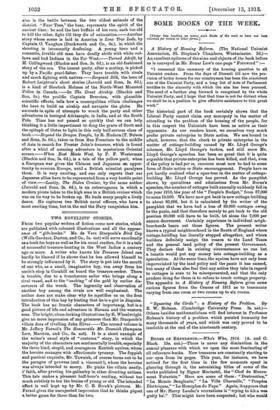TWO NOVELISTS' STORIES.
FROM two popular writers of fiction come new stories, which are published with coloured illustrations and all the appear- ance of " gift-books." Mr. de Vera Stacpoole's Bird Cay (Wells Gardner, Darton, and Co., 5s. net) will serve excellently as a book for boys as well as for his usual readers, for it is a tale of successful treasure-hunting in the West Indies a century ago or more. A writer who knows his Treasure Island can hardly be blamed if he shows that be has allowed himself to be strongly influenced by it. The story is put into the mouth of one who, as a small, imaginative boy, ran away from his uncle's shop in Cornhill on board the treasure-seeker. There is trouble, due to a treacherous sailor who brings along a rival vessel, and to the " caching " of the gold by earlier dis- coverers of the wreck. The ingenuity and observation of another boy among the rivals are well emphasized. The author does not make clear why he mystifies us on the first introduction of this boy by hinting that he is a girl in disguise. The book has no female characters of importance, but is a good picture of life and adventure in Havana and the western seas. The bright, clean-looking illustrations by R. Wheelwright give no more impression of any grimness than Mr. Stacpoole's villain does of rivalling John Silver.—The second volume is Mr. Jeffery Farnol's The Honourable Mr. Tawnish. (Sampson Low, Marston, and Co., 6s. net). It is a short example of the writer's usual style of " costume " story, in which the majority of the characters are sentimentally lovable, especially the three kind, stupid, and courageous Kentish squires, whom the heroine manages with affectionate tyranny. The foppish and poetical exquisite, Mr. Tawnish, of course turns out to be the paragon of prowess (and a viscount !), whom the heroine was always intended to marry. He pinks the villain neatly, i' faith, after proving his gallantry in other diverting actions. This tale makes a pleasant half-hour's reading, without too much subtlety to tax the brains of young or old. The intended effect is well kept up by Mr. C. E. Brook's pictures. Mr. Farnol gives the unexpected impression that he thinks piquet a better game for three than for two.


























































 Previous page
Previous page